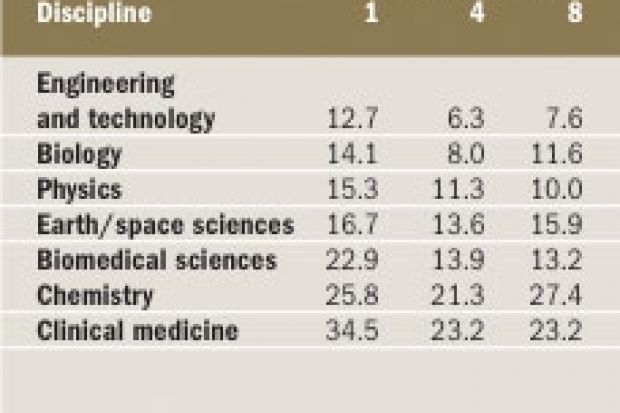One of the more imaginative suggestions recently for improving citation counts under the research excellence framework has been to use more colons in the titles of papers, but there is no evidence to suggest that such articles are more highly cited than those without them. Not in my research, anyway.
However, there are some intriguing findings about the use of colonic titles. Here are just four:
- The numbers of titles containing colons has been increasing over time in all disciplines;
- More authors in the arts and social sciences (often more than 50 per cent) employ colonic titles than do authors in the sciences (about 20 per cent or less);
- There are also differences in the use of colons within the sciences themselves (see Table 1);
- Single authors use colonic titles more than do pairs or groups of authors, until the numbers get quite large, for example, 12 or more (see Table 1)
Why are there these disciplinary differences? Possibly it is because the acceptance rates for submissions are higher in the sciences than in the social sciences. Authors in the sciences don't have to compete so much with one another, whereas those in the social sciences have to make their titles stand out more to catch an editor's eye. Or is it because natural scientists disown frivolity?
A compound construction for a title (for example, one with colons) allows authors to attract and to inform the reader more easily about the contents of their papers than does a full-sentence construction (one without a colon or a break). Text that attracts - "Lifting the veil on the viva" - and text that informs - "A study of 100 postgraduate students" - can be balanced around a colonic fulcrum. Normally attraction comes first, but not always.
The dual roles of attracting and informing can be seen more clearly in the titles of conference keynotes. Whereas 40 per cent of the conventionally delivered papers at the British Psychological Society's annual conferences (2003-05) were written in the colonic form, more than 50 per cent of the keynotes had colonic titles.
Authors use colons to help clarify the meanings of their titles, and this aids the readers' comprehension and recall. Uninformative titles can be made more explicit by using a colon and more exact writing. For example, compare the following.
- Original title: "Students' perspectives on constructivist learning";
- First revision: "Constructivist learning in higher education: students' perspectives";
- Second revision: "Constructivist learning in higher education: eight student interviews".
Few postgraduate or undergraduate students are taught how to write effective titles. Students need to be more aware of the strengths and weaknesses of different formats. Table 2 shows some titles for projects submitted by undergraduate psychology students, and some suggested revisions. Note how poor some of these original titles are - and how they can be improved by the use of colons, or a break of some kind.

Register to continue
Why register?
- Registration is free and only takes a moment
- Once registered, you can read 3 articles a month
- Sign up for our newsletter
Subscribe
Or subscribe for unlimited access to:
- Unlimited access to news, views, insights & reviews
- Digital editions
- Digital access to THE’s university and college rankings analysis
Already registered or a current subscriber? Login




